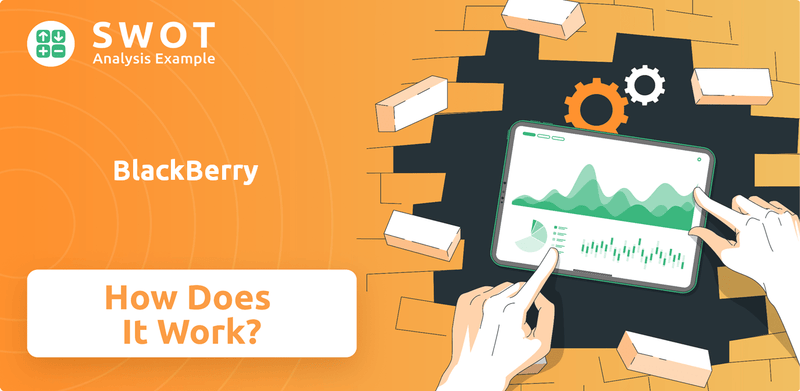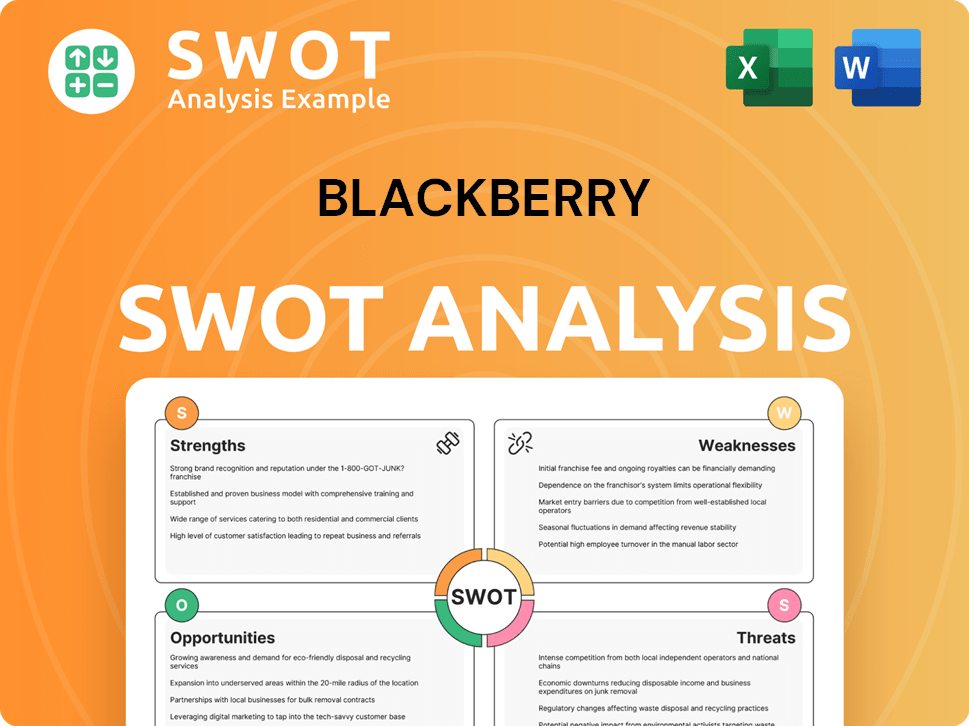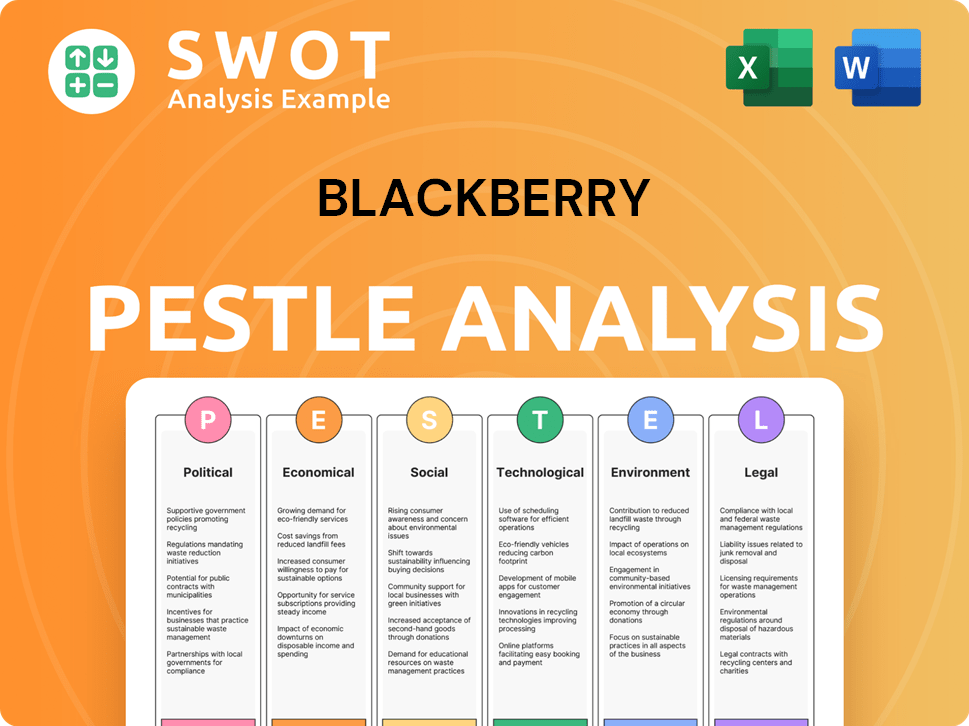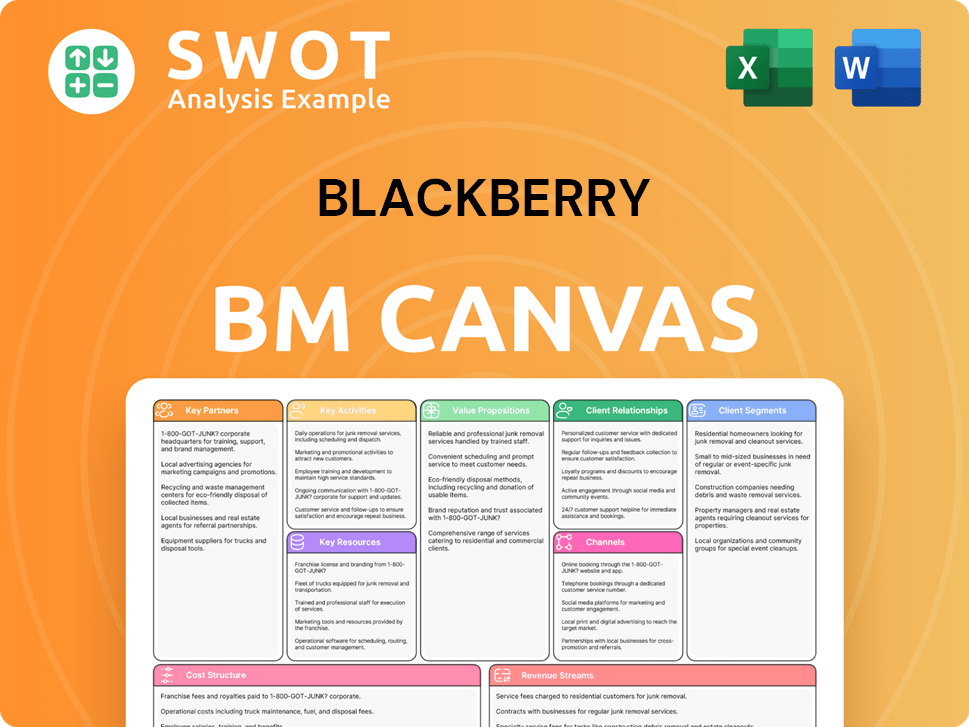BlackBerry Bundle
Is BlackBerry Still a Player in the Security Game?
Once a titan of the mobile world, the BlackBerry SWOT Analysis reveals a company that has dramatically reshaped itself. From iconic BlackBerry phones to a focus on cybersecurity, the company's transformation is a fascinating study in strategic adaptation. Understanding how this shift impacts its current operations and future prospects is key for anyone interested in the evolving tech landscape.

BlackBerry company's journey from BlackBerry devices to a software-focused enterprise is a testament to its resilience. This article explores how BlackBerry makes money in today's market, examining its core business, including its security features, and competitive advantages. We'll dissect its revenue streams and strategic moves to understand its current market position and long-term viability in the face of evolving threats and opportunities.
What Are the Key Operations Driving BlackBerry’s Success?
The core operations of the BlackBerry company are centered on providing intelligent security software and services. This is primarily achieved through two main segments: Cybersecurity and IoT (Internet of Things). The Cybersecurity segment focuses on securing endpoints, ranging from laptops and mobile devices to IoT devices, serving a diverse customer base.
The IoT segment, utilizing its QNX real-time operating system, specializes in embedded software for critical systems, especially in the automotive industry for advanced driver-assistance systems (ADAS) and infotainment. This also extends to general embedded systems for medical devices and industrial automation. The company's operational processes involve significant investment in research and development.
BlackBerry leverages a direct sales force for large enterprise and government clients, complemented by a strong channel partner program. Its software delivery is primarily digital, ensuring efficient deployment and updates. The company's heritage in security and experience in developing highly reliable software are key differentiators, leading to enhanced data protection and secure operation of connected systems.
BlackBerry's cybersecurity segment offers a comprehensive suite of products. These include endpoint protection, endpoint detection and response (EDR), and unified endpoint management (UEM) solutions. These offerings are designed to protect a wide array of devices.
The IoT segment is anchored by the QNX real-time operating system. This is used in embedded software for critical systems. A major application is in the automotive industry for ADAS and infotainment systems.
BlackBerry invests heavily in research and development. This is crucial for maintaining technological leadership. The focus includes continuous innovation in areas like artificial intelligence and machine learning for threat detection and prevention.
BlackBerry employs a direct sales force for large clients, along with a channel partner program. This approach allows the company to reach a broader market. Digital software delivery ensures efficient deployment and updates.
BlackBerry's value proposition centers on providing robust security solutions and reliable embedded systems. This is particularly important in an increasingly interconnected world. The company's focus on security and reliability differentiates it in the market.
- Enhanced Data Protection: BlackBerry solutions offer strong data protection.
- Regulatory Compliance: They help customers meet stringent regulatory requirements.
- Secure Operation: The company ensures the secure operation of connected systems.
- Focus on Security: The company's deep heritage in security is a key differentiator.
BlackBerry SWOT Analysis
- Complete SWOT Breakdown
- Fully Customizable
- Editable in Excel & Word
- Professional Formatting
- Investor-Ready Format

How Does BlackBerry Make Money?
The core of the BlackBerry company's financial strategy revolves around its ability to monetize its cybersecurity and IoT solutions. This approach has evolved significantly, moving away from its legacy hardware business to focus on software and services with recurring revenue streams. The company's revenue model is designed to provide a steady and predictable income flow.
BlackBerry's revenue streams are primarily segmented into Cybersecurity and IoT, with a strong emphasis on subscriptions and licensing. The company has strategically shifted its focus towards high-margin software businesses, which is reflected in its financial performance. This shift is a key element of its long-term growth strategy.
In fiscal year 2024, BlackBerry reported total revenue of $677 million. The Cybersecurity segment generated $374 million, primarily through subscriptions for its endpoint security and UEM solutions. The IoT segment contributed $218 million, driven by licensing of its QNX software for embedded systems.
BlackBerry employs several key monetization strategies to generate revenue and maintain a competitive edge. These strategies are designed to ensure a stable revenue stream and capitalize on the growing demand for cybersecurity and IoT solutions. The company's approach is centered on long-term value creation and customer retention.
- Annual Recurring Revenue (ARR) Model: For its software subscriptions, BlackBerry uses an ARR model. This allows for predictable revenue generation, which is crucial for financial planning and stability.
- Per-Unit Licensing for QNX: The QNX embedded software is typically licensed on a per-unit basis. Revenue is recognized based on the number of units shipped by BlackBerry's customers.
- Bundling Security Offerings: BlackBerry has explored bundling its security offerings to provide comprehensive solutions to enterprises. This approach enhances the value proposition for customers and increases revenue potential.
- Focus on Software and Services: The company has seen a shift in its revenue mix, with a growing emphasis on software and services, and a decline in legacy hardware and service access fees. For example, the Cybersecurity segment saw an increase in ARR in the fourth quarter of fiscal year 2024, reaching $294 million.
BlackBerry PESTLE Analysis
- Covers All 6 PESTLE Categories
- No Research Needed – Save Hours of Work
- Built by Experts, Trusted by Consultants
- Instant Download, Ready to Use
- 100% Editable, Fully Customizable

Which Strategic Decisions Have Shaped BlackBerry’s Business Model?
The transformation of the BlackBerry company is a story of strategic evolution. The company has shifted from its roots as a hardware manufacturer to a software and services provider. This strategic pivot has been a defining characteristic of its recent history, reshaping its business model and market focus.
A key move was the divestiture of its smartphone manufacturing operations. This strategic decision allowed BlackBerry to concentrate on enterprise software and the Internet of Things (IoT). This shift included the sale of patents related to mobile devices, messaging, and wireless networking in 2024, which further solidified its software-centric approach. The company now focuses on cybersecurity and embedded systems.
Operational challenges have included adapting its sales and marketing strategies to a software-as-a-service (SaaS) model and competing with established cybersecurity vendors. Despite these challenges, BlackBerry continues to leverage its strengths in security and its brand reputation to maintain a competitive edge.
BlackBerry's transition from hardware to software represents a major milestone. The sale of its smartphone manufacturing operations and related patents marked a definitive shift. This strategic move allowed the company to focus on its core strengths in cybersecurity and embedded systems.
The company's strategic moves include focusing on enterprise software, IoT, and cybersecurity. Investing in AI-driven threat detection and a unified platform approach is also key. These moves are designed to address evolving cyber threats and maintain a technological edge.
BlackBerry's competitive advantages lie in its security expertise and brand trust. The QNX operating system's dominance in the automotive market provides a strong foundation. This is coupled with AI-driven threat detection capabilities to offer a comprehensive security posture.
BlackBerry holds a significant position in the automotive embedded software market. The company's QNX operating system powers over 275 million vehicles globally as of fiscal year 2024. This strong presence in the automotive sector supports its market position.
BlackBerry's current strategy centers on cybersecurity, IoT, and embedded systems. The company is adapting to new trends by investing in areas like extended detection and response (XDR) and secure communications for regulated industries. This strategy aims to maintain its technological edge and address evolving cyber threats.
- The QNX operating system is a key asset, powering over 275 million vehicles globally.
- BlackBerry focuses on AI-driven threat detection and unified security platforms.
- The company continues to innovate in secure communications for regulated industries.
- For more insights, read about the Growth Strategy of BlackBerry.
BlackBerry Business Model Canvas
- Complete 9-Block Business Model Canvas
- Effortlessly Communicate Your Business Strategy
- Investor-Ready BMC Format
- 100% Editable and Customizable
- Clear and Structured Layout

How Is BlackBerry Positioning Itself for Continued Success?
The BlackBerry company holds a unique position in the cybersecurity and embedded systems sectors. While not a top-tier overall cybersecurity vendor, it has a strong presence in specialized areas, especially within government and regulated industries, due to its high-assurance security offerings. Its QNX software is a market leader in the automotive sector for embedded systems. The company faces competition from larger tech companies and specialized cybersecurity firms.
Key risks for BlackBerry include the fast-changing threat landscape, requiring continuous R&D investment. The competitive cybersecurity market also poses a risk, potentially leading to pricing pressures. Economic downturns could impact IT spending, affecting BlackBerry's revenue. Regulatory changes around data privacy and cybersecurity could also influence product development and compliance costs.
The BlackBerry company is positioned in cybersecurity and embedded systems, with a focus on government and automotive sectors. Its QNX software is a leader in the automotive embedded systems market. The company competes with larger, diversified tech firms and specialized cybersecurity companies. Learn more about the Target Market of BlackBerry.
The main risks include the evolving cyber threat landscape, which necessitates continuous investment in R&D. Intense competition in the cybersecurity market could lead to pricing pressures. Economic downturns and regulatory changes also pose significant challenges to the BlackBerry business model.
The future outlook focuses on leveraging strengths in IoT and cybersecurity. Strategic initiatives include expanding UEM and UES offerings, integrating AI into security products, and growing in the automotive software market. The company aims for positive free cash flow in fiscal year 2025.
The company is aiming for positive free cash flow in fiscal year 2025. The focus is on sustained revenue growth through innovation, partnerships, and high-margin software and services. This strategy aims to improve the financial performance of the BlackBerry company.
The company is expanding its UEM and UES offerings, integrating AI in security products, and growing in the automotive software market. These initiatives are designed to capitalize on the increasing complexity of software-defined vehicles and the growing need for robust cybersecurity solutions.
- Expanding UEM and UES offerings.
- Integrating AI into security products.
- Growing presence in the automotive software market.
- Focusing on high-growth, high-margin software and services.
BlackBerry Porter's Five Forces Analysis
- Covers All 5 Competitive Forces in Detail
- Structured for Consultants, Students, and Founders
- 100% Editable in Microsoft Word & Excel
- Instant Digital Download – Use Immediately
- Compatible with Mac & PC – Fully Unlocked

Related Blogs
- What are Mission Vision & Core Values of BlackBerry Company?
- What is Competitive Landscape of BlackBerry Company?
- What is Growth Strategy and Future Prospects of BlackBerry Company?
- What is Sales and Marketing Strategy of BlackBerry Company?
- What is Brief History of BlackBerry Company?
- Who Owns BlackBerry Company?
- What is Customer Demographics and Target Market of BlackBerry Company?
Disclaimer
All information, articles, and product details provided on this website are for general informational and educational purposes only. We do not claim any ownership over, nor do we intend to infringe upon, any trademarks, copyrights, logos, brand names, or other intellectual property mentioned or depicted on this site. Such intellectual property remains the property of its respective owners, and any references here are made solely for identification or informational purposes, without implying any affiliation, endorsement, or partnership.
We make no representations or warranties, express or implied, regarding the accuracy, completeness, or suitability of any content or products presented. Nothing on this website should be construed as legal, tax, investment, financial, medical, or other professional advice. In addition, no part of this site—including articles or product references—constitutes a solicitation, recommendation, endorsement, advertisement, or offer to buy or sell any securities, franchises, or other financial instruments, particularly in jurisdictions where such activity would be unlawful.
All content is of a general nature and may not address the specific circumstances of any individual or entity. It is not a substitute for professional advice or services. Any actions you take based on the information provided here are strictly at your own risk. You accept full responsibility for any decisions or outcomes arising from your use of this website and agree to release us from any liability in connection with your use of, or reliance upon, the content or products found herein.